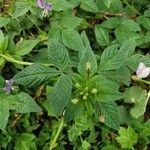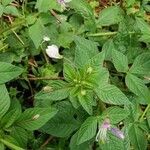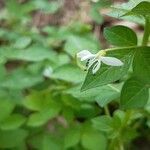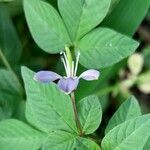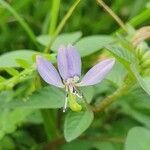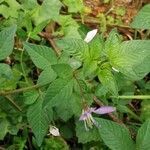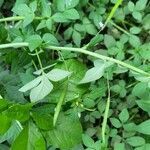Herbs, annual or rarely perennial, 30-100 cm tall. Stems branched, often with decumbent branches, glabrous or glabrescent to slightly scabrous but sometimes glandular pubescent. Stipules ca. 0.5 mm, scalelike or absent. Petiole 0.5-3.5 cm, proximally winged; leaflets 3; leaflet blades oblanceolate to rhomboid-elliptic, 1-3.5 × 0.5-1.7 cm, abaxially with curved trichomes on veins especially when young, adaxially glabrous, margins entire or serrulate-ciliate, apex acute, obtuse, or sometimes acuminate. Inflorescences terminal and axillary, 2-4 cm but 8-15 cm in fruit, 3-6-flowered; bracts leaflike, 3-foliate, 1-3.5 cm. Pedicel 1.1-2.1 cm but 1.8-3 cm in fruit. Sepals yellow, narrowly lanceolate, 2.5-4 × 0.2-0.3 mm, ± persistent, glabrous, margin ciliate. Petals white or speckled with purple, oblong to narrowly ovate, 7-10 × 1.5-2.3 mm; central 2 petals outside with a yellow transverse band. Filaments yellow, 5-7 mm; anthers purplish brown, 1-2 mm. Pistil 2-3 mm, glabrous; style 0.5-1.4 mm. Fruit with a 4-12 mm gynophore; capsule 40-70 × 3-4 mm, striate. Seeds 4-25 per capsule, reddish brown to black with white funicular aril, 1-1.5 mm, slender, striately verrucose. Fl. and fr. Jun-Sep. 2n = 20, 30.
Annuals or perennials, 30-100 cm. Stems sparsely branched, (often decumbent); glabrous or glabrescent to slightly scabrous (sometimes glandular-pubescent). Leaves: stipules 0-0.5 mm; petiole (winged proximally), 0.5-3.5 cm; leaflets 3, blade oblanceolate to rhombic-elliptic, 1-3.5 × 0.5-1.7 cm, margins entire or serrulate-ciliate, apex usually acute to obtuse, sometimes acuminate, surfaces with curved hairs on veins abaxially, glabrous adaxially. Racemes 2-4 cm (8-15 cm in fruit); bracts trifoliate, 10-35 mm. Pedicels 11-21 mm (18-30 mm in fruit). Flowers: sepals yellow, lanceolate, 2.5-4 × 0.2-0.3 mm, margins denticulate, ciliate, glabrous; petals white or purple-speckled (2 central ones with yellow transverse band abaxially), oblong to narrowly ovate, 7-10 × 1.5-2.3 mm; stamens yellow, 5-7 mm; anthers 1-2 mm; gynophore 4-12 mm in fruit; ovary 2-3 mm, glabrous; style 0.5-1.4 mm. Capsules 40-70 × 3-4 mm. Seeds 4-25, reddish brown to black, reniform, 1-1.5 mm, arillate.
Annual herb, branched, rather weak but erect, up to 5 dm.. Stem with few or more rarely many eglandular hairs or stalked glands on the upper part.. Leaves petiolate, 3-foliolate; leaflets elliptic, obovate-elliptic or practically rhombic, 1–6 cm. long, 0.4–1.8 cm. wide, glabrous or sparsely setulose-pubescent; petiole up to 7 cm. long.. Inflorescence lax and not clearly demarcated, very short or up to 20 cm. long; bracts usually similar in size to the leaves.. Sepals linear to linear-lanceolate, (2–)3–4.5 mm. long, glandular-puberulent.. Petals pink or magenta, ± 1 cm. long.. Stamens 6.. Gynophore 5–8(–13) mm. long.. Capsules 3–6 cm. long, glabrous or subglabrous.. Seeds ±1.8 mm. in diameter, orange to brown, with fine longitudinal striations and low irregular transverse ridges.. Fig. 2/18.
Spreading, widely branching, annual herb to 1 m high, sparsely covered in small, coarse bristles, not strongly foetid. Leaves 3-foliate; leaflets to 3 cm long and 2 cm wide, with coarse bristles especially on margins. Sepals with short bristles. Petals 9–12 mm long, violet-blue turning pink, the 2 central petals with a yellow band; claw short, 2–3 mm long; all 4 petals strongly swept upwards. Stamens 6, free. Ovary on a short gynophore, which lengthens greatly after anthesis, forming a 4–8 mm long stalk separating capsule from corolla scar. Capsule glabrous; valves deciduous. Seeds ribbed, with a white elaiosome.
An annual herb. It grows 50 cm tall. It branches from the base. The stems have fine hairs. The leaves are alternate and have 3 leaflets. The leaf stalks is 7 cm long. The leaflets are 1-6 cm long by 1-2.5 cm wide.
